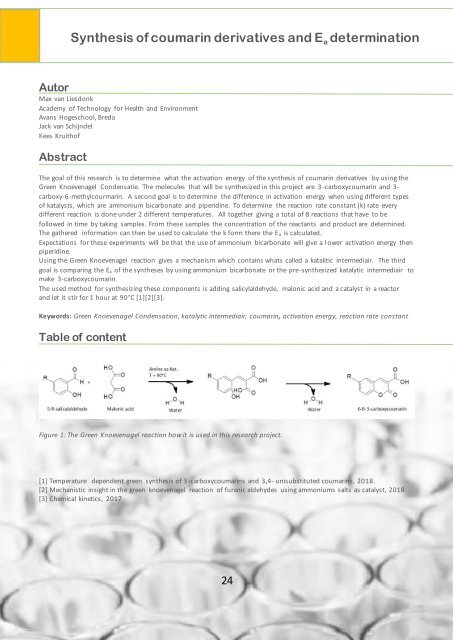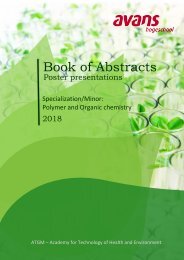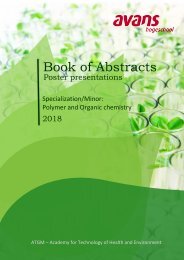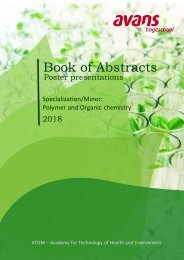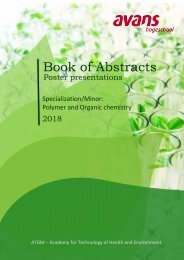Book of abstracts version 5
You also want an ePaper? Increase the reach of your titles
YUMPU automatically turns print PDFs into web optimized ePapers that Google loves.
Synthesis <strong>of</strong> coumarin derivatives and E a determination<br />
Autor<br />
Max van Liesdonk<br />
Academy <strong>of</strong> Technology for Health and Environment<br />
Avans Hogeschool, Breda<br />
Jack van Schijndel<br />
Kees Kruith<strong>of</strong><br />
oumarin derivatives and E a determination<br />
Abstract<br />
The goal <strong>of</strong> this research is to determine what the activation energy <strong>of</strong> the synthesis <strong>of</strong> coumarin derivatives by using the<br />
Green Knoevenagel Condensatie. The molecules that will be synthesized in this project are 3 -carboxycoumarin and 3-<br />
carboxy-6-methylcourmarin. A second goal is to determine the difference in activation energy when using different types<br />
<strong>of</strong> katalysts, which are ammonium bicarbonate and piperidine. To determine the reaction rate constant (k) rate every<br />
different reaction is done under 2 different temperatures. All together giving a total <strong>of</strong> 8 reactions that have to be<br />
followed in time by taking samples. From these samples the concentration <strong>of</strong> the reactants and product are determined.<br />
The gathered information can then be used to calculate the k form there the E a is calculated.<br />
Expectations for these experiments will be that the use <strong>of</strong> ammonium bicarbonate will give a lower activation energy then<br />
piperidine.<br />
Using the Green Knoevenagel reaction gives a mechanism which contains whats called a katalitic intermediair. The third<br />
goal is comparing the E a <strong>of</strong> the syntheses by using ammonium bicarbonate or the pre-synthesized katalytic intermediair to<br />
make 3-carboxycoumarin.<br />
The used method for synthesizing these components is adding salicylaldehyde, malonic acid and a catalyst in a reactor<br />
and let it stir for 1 hour at 90°C [1][2][3].<br />
Keywords: Green Knoevenagel Condensation, katalytic intermediair, coumarin, activation energy, reaction rate constant<br />
Table <strong>of</strong> content<br />
Figure 1: The Green Knoevenagel reaction how it is used in this research project.<br />
[1] Temperature dependent green synthesis <strong>of</strong> 3-carboxycoumarins and 3,4- unisubstituted coumarins, 2018.<br />
[2] Mechanistic insight in the green knoevenagel reaction <strong>of</strong> furanic aldehydes using ammoniums salts as catalyst, 2018<br />
[3] Chemical kinetics, 2017<br />
24


